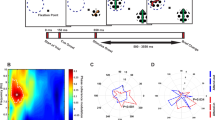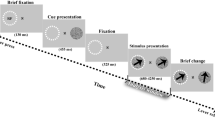Abstract
THE way in which the brain integrates fragmentary neural events at multiple locations to produce unified perceptual experience and behaviour is called the binding problem1,2. Binding has been proposed to involve correlated activity at different cortical sites during perceptuomotor behaviour3–5, particularly by synchronization of narrow-band oscillations in the & gamma;-frequency range (30& ndash;80 Hz)6,7. In the rabbit olfactory system, inhalation induces increased & gamma;-cor-relation between sites in olfactory bulb and cortex8. In the cat visual system, coherent visual stimuli increase & gamma;-correlation between sites in both the same and different visual cortical areas9–12. In monkeys, some groups have found that & gamma;-oscillations transiently synchronize within striate cortex13, superior temporal sulcus14 and somatosensorimotor cortex15,16. Others have reported that visual stimuli produce increased broad-band power, but not & gamma;-oscillations, in several visual cortical areas17,18. But the absence of narrow-band oscillations in itself does not disprove interregional synchronization, which may be a broad-band phenomenon. We now describe episodes of increased broad-band coherence among local field potentials from sensory, motor and higher-order cortical sites of macaque monkeys performing a visual discrimination task. Widely distributed sites become coherent without involving other intervening sites. Spatially selective multiregional cortical binding, in the form of broad-band synchronization, may thus play a role in primate perceptuomotor behaviour.
This is a preview of subscription content, access via your institution
Access options
Subscribe to this journal
Receive 51 print issues and online access
$199.00 per year
only $3.90 per issue
Buy this article
- Purchase on Springer Link
- Instant access to full article PDF
Prices may be subject to local taxes which are calculated during checkout
Similar content being viewed by others
References
Damasio, A. R. Neural Comput. 1, 123–132 (1989).
Singer, W. A. Rev. Physiol. 55, 349–374 (1993).
von der Malsburg, C. & Schneider, W. Biol. Cybern. 54, 29–40 (1986).
Abeles, M. Local Cortical Circuits (Springer, Berlin, 1982).
Engel, A. K. et al. Trends Neurosci. 15, 218–226 (1992).
Bressler, S. L. Trends Neurosci. 13, 161–162 (1990).
Crick, F. & Koch, C. Semin. Neurosci. 2, 263–275 (1990).
Bressler, S. L. Brain Res. 409, 285–293 (1987).
Gray, C. M., Konig, P., Engel, A. K. & Singer, W. Nature 338, 334–337 (1989).
Engel, A. K., Konig, P., Kreiter, A. K. & Singer, W. Science 252, 1177–1179 (1991).
Engel, A. K., Kreiter, A. K., Konig, P. & Singer, W. Proc. natn. Acad. Sci. U.S.A. 88, 6048–6052 (1991).
Eckhorn, R. et al. Biol. Cybern. 60, 121–130 (1988).
Freeman, W. J. & van Dijk, B. W. Brain Res. 422, 267–276 (1987).
Kreiter, A. K. & Singer, W. Eur. J. Neurosci. 4, 369–375 (1992).
Murthy, V. N. & Fetz, E. E. Proc. natn. Acad. Sci. U.S.A. 89, 5670–5674 (1992).
Sanes, J. N. & Donoghue, J. P. Proc. natn. Acad. Sci. U.S.A. 90, 4470–4474 (1993).
Young, M. P., Tanaka, K. & Yamane, S. J. Neurophys. 67, 1464–1474 (1992).
Tovee, M. J. & Rolls, E. T. Neuroreport 3, 369–372 (1992).
Glaser, E. M. & Ruchkin, D. S. Principles of Neurobiological Signal Analysis 168–176 (Academic, New York, 1976).
Gray, C. M., Konig, P., Engel, A. K. & Singer, W. Vis. Neurosci. 8, 337–347 (1992).
Pfurtscheller, G. & Neuper, C. Neuroreport 3, 1057–1060 (1992).
Gevins, A. S. & Bressler, S. L. in Functional Brain Imaging (eds Pfurtscheller, G. & Lopes da Silva, F. H.) 99–116 (Hans Huber, Bern, 1988).
Gevins, A. S. et al. Science 235, 580–585 (1987).
Livanov, M. N. Spatial Organization of Cerebral Processes (Wiley, New York, 1977).
Sheer, D. E. in Molecular Mechanisms in Memory and Learning (ed. Ungar, G.) 177–211 (Plenum, New York, 1970).
Bressler, S. L. & Nakamura, R. in Computation and Neural Systems (eds Eeckman, F. & Bower, J. M.) 515–522 (Kluwer, Norwell, Massachusetts, 1993).
Author information
Authors and Affiliations
Rights and permissions
About this article
Cite this article
Bressler, S., Coppola, R. & Nakamura, R. Episodic multiregional cortical coherence at multiple frequencies during visual task performance. Nature 366, 153–156 (1993). https://doi.org/10.1038/366153a0
Received:
Accepted:
Issue Date:
DOI: https://doi.org/10.1038/366153a0
This article is cited by
-
Neural evidence for lexical parafoveal processing
Nature Communications (2021)
-
A symbolic information approach to characterize response-related differences in cortical activity during a Go/No-Go task
Nonlinear Dynamics (2021)
-
Visual cortex recruitment during language processing in blind individuals is explained by Hebbian learning
Scientific Reports (2019)
-
Spectral fingerprints of large-scale neuronal interactions
Nature Reviews Neuroscience (2012)
Comments
By submitting a comment you agree to abide by our Terms and Community Guidelines. If you find something abusive or that does not comply with our terms or guidelines please flag it as inappropriate.



